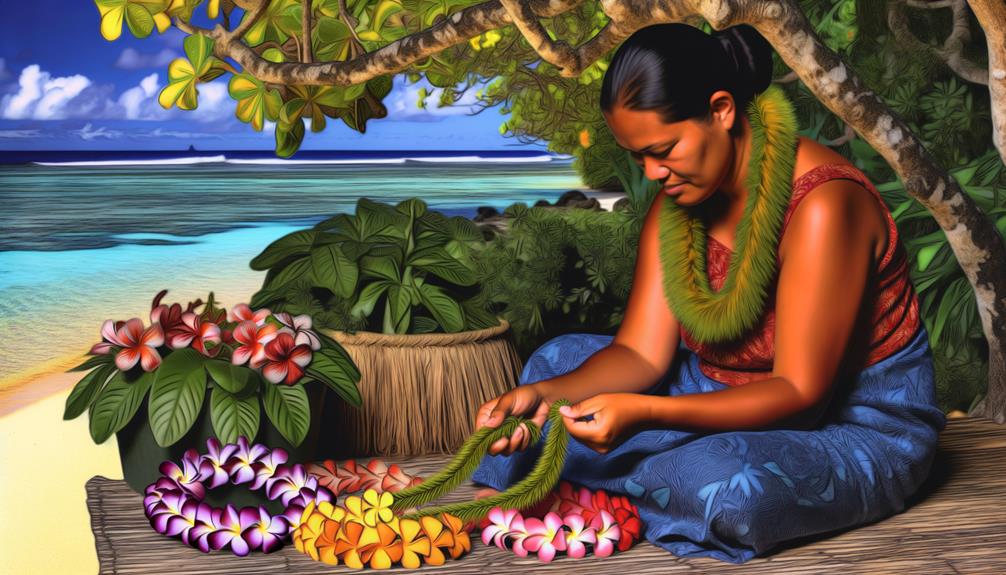5 Insights Into Hawaii's Traditional Lei Ceremonies
You may think that traditional lei ceremonies are simply a tourist attraction, but there’s much more to these beautiful and meaningful rituals than meets the eye.
From the historical significance of lei in Hawaii to the symbolism and etiquette involved, there are insights into these traditional ceremonies that shed light on the depth and importance of this cultural practice.
Understanding the deeper meaning behind lei ceremonies can offer a profound appreciation for the traditions and values they represent, providing a fascinating glimpse into the heart of Hawaiian culture.
Key Takeaways
- Lei have a long-standing historical and cultural significance in Hawaii and Polynesian societies.
- Lei ceremonies mark important events and symbolize love, respect, and cultural heritage.
- Lei-making is a cherished practice that embodies Hawaiian tradition and the interconnectedness of people and nature.
- The modern adaptations of lei ceremonies include Lei Day festivities and the incorporation of various materials, reflecting the enduring traditions and values of Hawaiian culture.
Historical Significance of Lei (Garlands) in Hawaii
Lei, the traditional garlands of Hawaii, have held significant historical importance in the islands for centuries. This Hawaiian tradition of adorning oneself with a lei has deep roots in the culture of the Hawaiian Islands. The flower lei, in particular, is a cherished symbol of love, respect, and aloha in Hawaiian culture.
Poet Don Blanding once said, ‘Wear a lei and keep a little bit of Hawaii with you.’ Lei ceremonies have been an integral part of Hawaiian life, marking important events such as births, graduations, and weddings. The lei represents the spirit of aloha, embodying the warmth and hospitality of the Hawaiian people.
Its historical significance is a testament to the enduring traditions and values of the Hawaiian culture.
Cultural and Ceremonial Uses in Polynesian Societies
The historical significance of lei in Hawaii provides valuable insights into the cultural and ceremonial uses of similar adornments in Polynesian societies, reflecting the deep-rooted traditions and symbolic meanings across the region.
The lei tradition holds great cultural and ceremonial importance, not only in Hawaii but also among Polynesian voyagers and ancient Hawaiians. Making a lei is a cherished practice that embodies the spirit of Hawaiian tradition, serving as a gesture of welcome, affection, and celebration.
The arrival at the airport is often greeted with the presentation of lei, symbolizing the warmth and hospitality deeply ingrained in Polynesian societies. The cultural and ceremonial uses of lei extend beyond mere decoration, embodying love, respect, and the interconnectedness of people and nature.
Symbolism and Meaning of Traditional Lei Ceremonies
Symbolizing love, respect, and cultural heritage, traditional lei ceremonies in Hawaii hold profound symbolic meaning and significance.
The Hawaiian lei, typically made from flowers, leaves, shells, or even feathers, is a tangible expression of aloha and is commonly worn or gifted to celebrate significant milestones such as graduations, weddings, or welcoming visitors.
The act of refusing a lei is considered disrespectful in Hawaiian culture, as it symbolizes a rejection of the person’s aloha spirit.
The making of a lei is a labor of love, with each element carefully selected and woven together to create a beautiful and meaningful adornment.
The Maile vine, a fragrant and revered plant, is often used in lei-making and is considered a symbol of peace, love, and new beginnings.
Wearing a lei is a gesture of honor, gratitude, and affection, embodying the essence of Hawaiian traditions and values.
Protocol and Etiquette in Lei Ceremonies
During traditional lei ceremonies in Hawaii, it’s customary to gently drape the lei over the recipient’s shoulders as a sign of respect and honor. When participating in lei ceremonies on Hawaii Island, it’s important to adhere to the protocol and etiquette to show proper respect.
Here are some key points to remember:
- Family Members: Family members are usually the first ones to present the lei to the recipient, signifying their love and support.
- Kiss on the Cheek: It’s customary for the recipient to kiss the giver on the cheek or embrace them as a sign of gratitude for the lei.
- Considered Rude: It’s considered rude to refuse a lei or to remove it in the presence of the person who gave it to you.
Remember to show appreciation and respect for the lei and the traditions it represents.
Evolution and Modern Adaptations of Lei Ceremonies
As lei ceremonies have evolved over time, Lei Day, established in 1928, stands out as a significant modern adaptation, honoring the traditional Hawaiian practice of creating and wearing leis.
Leis have transitioned from being primarily made of flowers to incorporating various materials such as candy, money, and even miniature whiskey bottles, reflecting modern adaptations.
The tradition of giving leis has expanded beyond ceremonial events to become a regular part of birthdays, anniversaries, weddings, and graduations, showcasing the evolution of lei ceremonies.
Lei Day festivities now include lei parades, Hawaiian music, dance, crafts, and food, demonstrating the modern adaptations of lei ceremonies.
Crafting leis has evolved as a form of expression, allowing individuals to inject their own Aloha into the leis and showcase appreciation and love.
Hawaiians have brought the ancient practice of wearing bone and teeth leis around their neck into the present, and this evolution continues to be a beautiful blend of singular and plural expressions of respect and affection.






